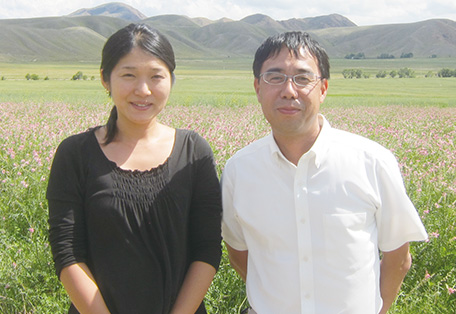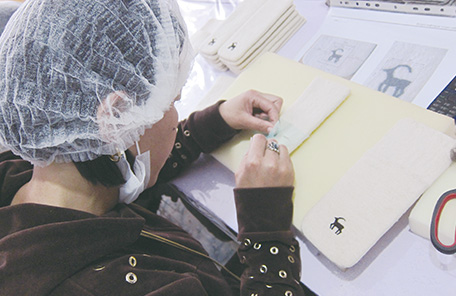Japan's Official Development Assistance White Paper 2013
Stories from the field 14
Promoting Growth among Craftspeople through Japanese Corporate Quality Standards
– Global Debut of Kyrgyz Felt Products at MUJI –

Ms. Masuda (left) and Mr. Haraguchi stand in front of a sainfoin field used for making dye. (Photo: Akiko Masuda)
The Kyrgyz Republic is a country of about 5.4 million people, situated between China and Kazakhstan. Since 2007, JICA has been carrying out in the surrounding areas of Lake Issyk-Kul the “Community empowerment in Issyk-Kul Oblast Project” as part of its One Village, One Product (OVOP)* movement.
During the Soviet era, many village communities were formed around agricultural farms. But many of the communities declined after the fall of the Soviet Union. Today, 20 years later, there is almost no information sharing or joint work among residents within the same communities, and there are few opportunities for the members of each village gathering for events like local festivals. The problem of community decline is becoming more and more serious as a large number of people become migrant workers due to the stagnation in the agricultural industry. The aforementioned project was started as an initiative to revitalize the country’s rural areas and to strengthen its communities through the development and sale of OVOP products making use of natural resources of the Kyrgyz Republic, a mountain country – herbs, honey, wool, fruit, wild berries, and other produce.
Mr. Akihisa Haraguchi served as Chief Adviser on this project. He explains that at first, the people of the Kyrgyz Republic were unable to move beyond the mindset established during the Soviet era, “In the beginning, people in the area only asked us to provide production machines or to construct an OVOP factory.” The project made deliberate efforts in promoting a sense of ownership of participants, facilitating information sharing, and creating an effective production system.
The project reached a turning point in 2010. Ryohin Keikaku Co., Ltd., the company that runs the MUJI line of stores, including over 200 shops outside of Japan, was considering plans for Christmas gift products with a charity aspect. Ms. Akiko Masuda, who was in charge of planning the project, came to know of the support JICA was providing for the craftspeople of developing countries, and she approached JICA for possible collaboration in product development. Among the products developed by JICA’s OVOP movement, Kyrgyz-made felt handicrafts were chosen for the collaboration.
Key to the decision was the warm and traditional feel of all handmade felt products and the quick response from the people of the country. Thus started the MUJI x JICA project.
The felt goods are produced by 25 groups living within an area up to 700 km around Issyk-Kul Lake. There was uncertainty about whether such a disparate group of producers could meet tough quality standards of a global brand. The project started by training a technical leader from each group. Most of the trainees were housewives. Project staff then visited each group and made sure that the quality is maintained according to strict standards. Ryohin Keikaku also conducted its own training during which it elaborately communicated the importance of quality and the way the products were sold around the world, while also listening to the opinions of the producers. Ms. Masuda encouraged the producers by explaining that their products would be sold all across the world if they cleared MUJI’s quality standards.
Kyrgyz felt card holders and other small felt items hit the shelves globally at MUJI stores for the 2011 Christmas season. Orders grew from 10,000 units in the first year to over 20,000 units in 2013. Inspection, tag attachment, and packaging, once done in Japan, were all completed in the Kyrgyz Republic in 2013. For Ms. Masuda, watching how Kyrgyz people develop their abilities is more emotionally moving than anything else.
“Every time I visit the area, I can feel how their attitudes towards quality control have improved. The women who learned techniques from the experts can then instruct others in the following year. The women talk to each other while they work, which creates a sense of community. As a corporation, we gained a lot as we learned that we can make social contribution by pursuing our main business.”
Mr. Haraguchi speaks about the large impact of collaboration with a corporation. “Up until now, it was common for the businesses of the Kyrgyz Republic to miss delivery deadlines. Products qualities varied, and there were no established rules for the production process. I think that the collaborating corporation has provided excellent training opportunity by really putting pressure on the producers.”
The Kyrgyz Republic project shows us that it is possible to bring out the potential of people and regions of developing countries through collaborative initiatives between Japan’s ODA and Japanese corporations – companies with the world’s highest quality standards.
* For more information on OVOP movement, see this page.

A village woman carefully stitches an animal pattern using a grey thread. (Photo: Akiko Masuda)
